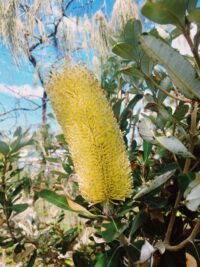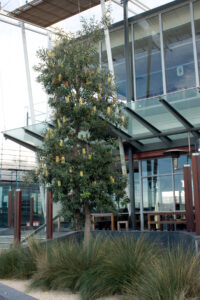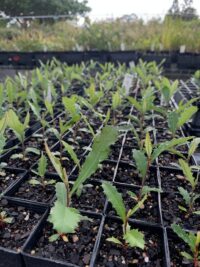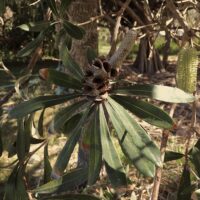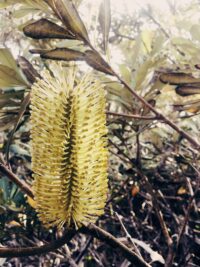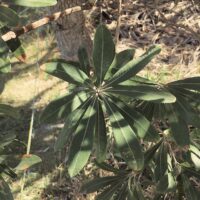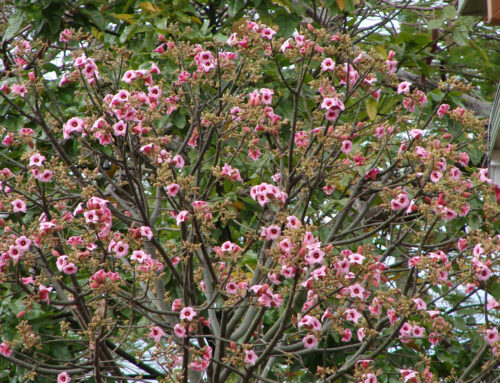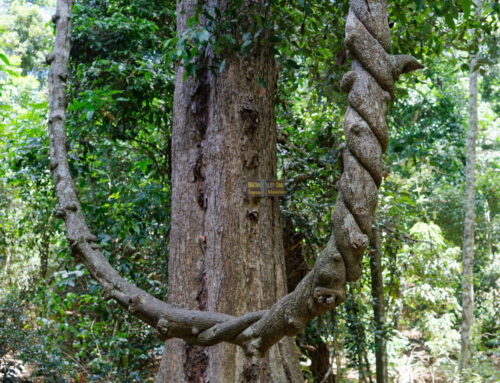Pronunciation: Banksia (BANKS-ee-ah) integrifolia (in-teg-rah-FOAL-ee-ah)
Banksia integrifolia, commonly known as the coast banksia, is an Australian native tree.
Notable for its striking foliage, unique flower spikes, and adaptability to various environments.
Taxonomy:
- Family: Proteaceae
- Genus: Banksia
Description:
- Growth: Shrub, typically between 2 to 4 meters (6.5–13 feet) high in coastal, wind-exposed areas. In sheltered areas it may reach a height of up to 25 meters, with a spread of 4–8 meters.
- Leaves: Distinctive, tough, narrow, and lance-shaped, ranging from 4 to 20 cm in length. The upper surface is glossy green, while the underside has a silvery or white appearance due to a dense covering of hairs.
- Flowers: Cylindrical flower spikes, or inflorescences, can grow 10–20 cm in length and about 5 cm in diameter. They are usually pale yellow or cream-colored, becoming golden as they mature. Flowering occurs predominantly from late summer to winter.
- Seed: Woody cones form that contain seed follicles. Each follicle may release one or two seeds and opens only after environmental triggers like fire or desiccation.
Habitat and Distribution:
Found along Australia’s eastern seaboard, from Victoria in the south, through New South Wales, and up into central Queensland. It is especially common along the coastal fringes but also found inland. Grows in diverse environments, including sandy coastal dunes, rocky outcrops, scrubland, and occasionally in mountainous areas. It can tolerate poor, sandy, and rocky soils as well as salt-laden winds.
Hosts: (included but not limited to)
- Noisy Friarbird (Philemon corniculatus): This large honeyeater species is another significant pollinator, attracted by the abundant nectar.
- Grey-Headed Flying Fox (Pteropus poliocephalus): This native fruit bat, which is also a key pollinator, feeds on the nectar and pollen of Banksia flowers. As they move between trees, they assist in cross-pollination, particularly at night.
- Lesser Long-Eared Bat (Nyctophilus geoffroyi): A small insectivorous bat that also occasionally feeds on nectar from Banksia flowers. Though more commonly insect-eating, this bat may incidentally contribute to pollination.
- Brown Antechinus (Antechinus stuartii): This small marsupial is known to forage on Banksia seeds and flowers, helping with seed dispersal through its movement.
- Yellow-Tailed Black Cockatoo (Calyptorhynchus funereus): Known for breaking open Banksia cones to access the seeds, this cockatoo plays a vital role in opening cones and dispersing seeds, even though it also consumes a significant portion.
- Australian Banksia Moth (Xylorycta strigata): The larvae of this moth bore into the stems and branches of Banksia species, causing structural damage that can weaken the tree over time.
- Eastern Yellow Robin (Eopsaltria australis): This insectivorous bird frequently hunts for insects, especially around flower spikes where insects congregate.
Ecology and Uses:
- Erosion Control: Because of its root structure and tolerance of sandy soils, coast banksia is commonly planted on dunes and slopes to help prevent erosion.
- Ornamental Tree: Popular in landscaping due to its aesthetic foliage, flowers, and resilience. It’s widely used in gardens, public parks, and as a street tree.
- Commerical: Flowers are sometimes harvested for the cut flower industry, and the woody cones are used in floristry and craft.
- Bushfood: Shake the flowers into a container of water or directly suck the nectar from the flower spikes as a natural sweetener.
- Windbreaks: Tolerance to salt spray and high winds makes it an effective windbreak in coastal and inland areas. When planted in groups, it can protect other plants and crops from strong winds.
Links:
Species profile—Banksia integrifolia | Environment, land and water | Queensland Government
Banksia integrifolia : Coast Banksia | Atlas of Living Australia

